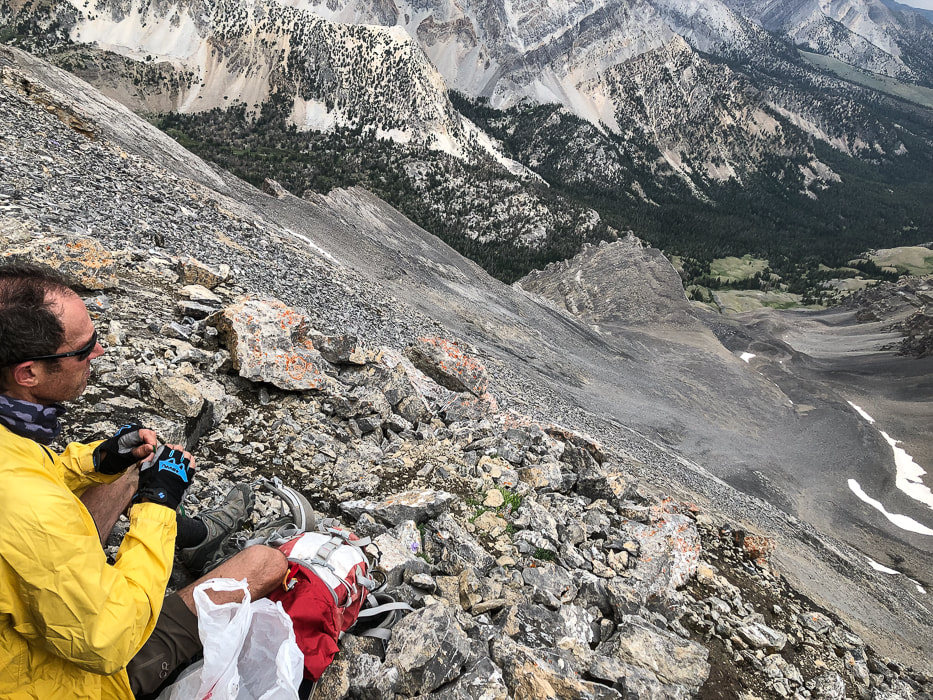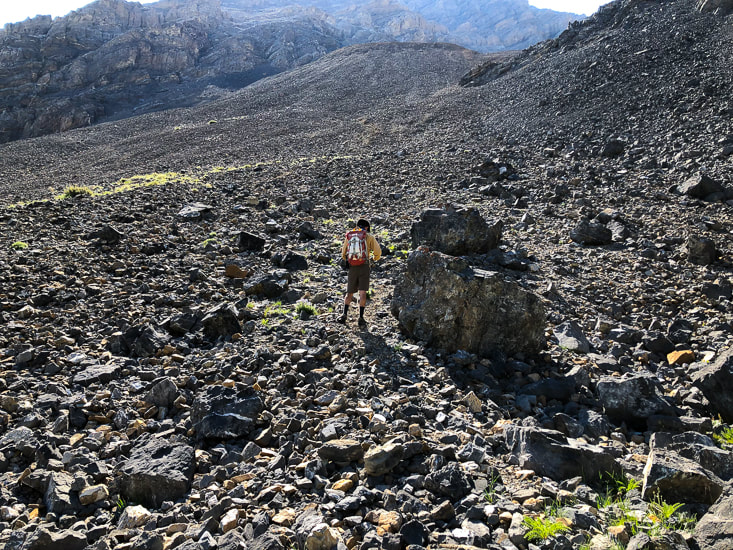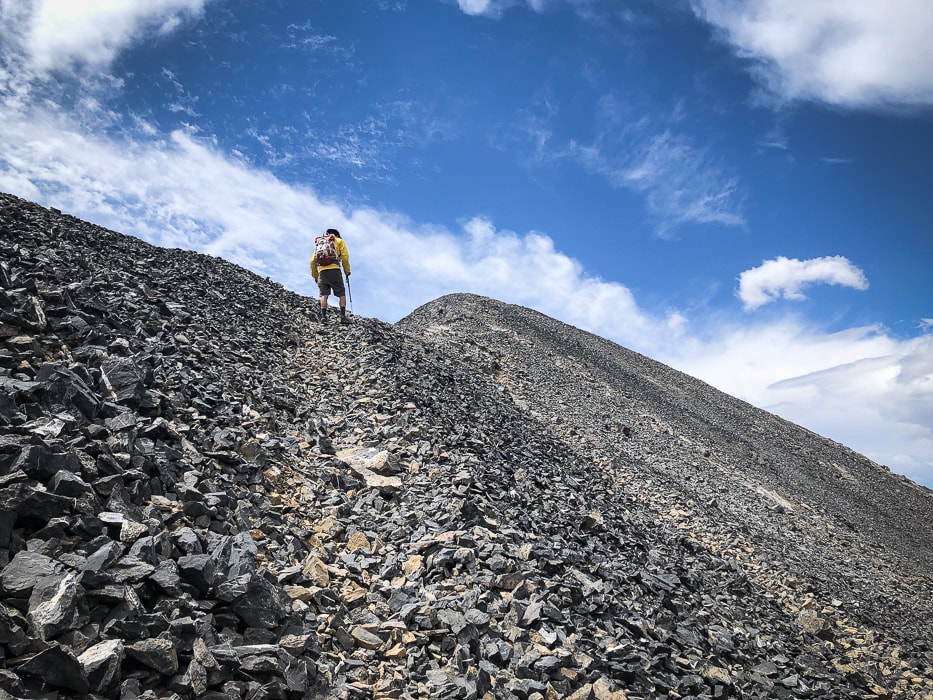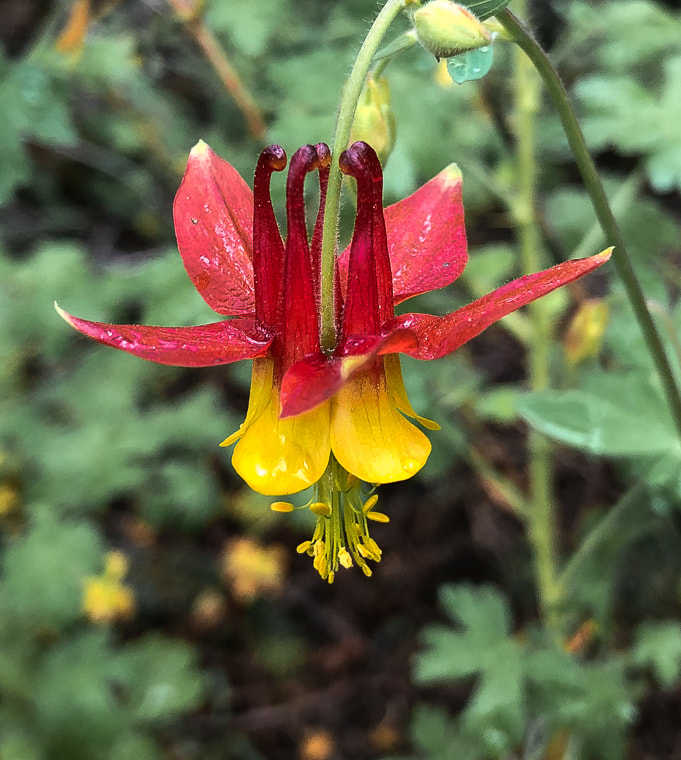|
A challenging climb up the loose-rock north side of Idaho's second tallest peak for spectacular views from the "roof" of Idaho.
Related Posts
Idaho Summits (see Categories in sidebar) Mackay Peak, 10, 273' and Mackay Mine Hill Tour Cowboys and Hotsprings Alpine Peak 9,861' - Sawtooth Wilderness: Never Stop Climbing Mountains Reward Peak: 10,074' via Upper Redfish Lakes, Sawtooth Wilderness
Lunch break at 12,000 feet.
Lunch spot on Leatherman Peak's north slope
Mt. Borah, Idaho's tallest peak at 12,667' on left horizon. Road approaching trailhead at upper right; trail goes through pleasant forest in valley.
Trip Stats
Location: Leatherman Peak, Idaho's second highest, is located in the Lost River Range in the Salmon-Challis National Forest just northeast of Mackay in east-central Idaho. This rugged range includes seven of the nine "12-ers" - the highest peaks in Idaho. Two main approaches: south approach from Leatherman Pass (Lost River Valley) that climbs the west ridge, and north approach from Pahsimeroi Valley and West Fork Pahsimeroi Road climbs the east ridge (our approach). Distance: 8.7 miles round-trip. Elevation Gain: Trailhead = 8,171'; Leatherman summit = 12,228: Gain = 4,000'. Date Hiked: July 7, 2021 Difficulty: Moderate Class 1 for first 1,000 feet gain, then Very Strenuous Class 2 on loose rock with some route-finding. Considerations: This is a very strenuous hike that is exposed most of the way - start hike early! Obvious trails extend through the talus and on the ridge. Experience with steep loose-rock climbing and route finding is essential. Coordinates: Trailhead at end of West Fork Pahsimeroi Road: 44.1292 N 113.7271 W. Leatherman Peak: 44.0820 N 113.7330 W. Maps and Apps: USGS Leatherman 7.5 min quad topo, AllTrails GPS tracks. Interactive Map and Google Earth image of our GPS tracks below. Geology: Sedimentary rocks - marine limestone of Mississippian carbonate banks and turbiditic sandstone and mudstone and conglomerate of Antler flysch trough ~350 Ma (Million years ago). Crinoid and coral fossils. Leatherman Peak is a sharp horn carved from Mississippian Scott Peak Formation. Some of these rocks were intruded with dikes that baked the rock ~ 45-50 Ma, producing flourite veins. This section of the Lost River range rose due to the Mackay section of the Lost River Fault. History: Leatherman Peak is named after Henry Leatherman, one of the Lost River Valley's pioneers from the 1860's. For more interesting history of this region, see last photo below.
Our Hike
The raw and starkly beautiful Lost River Range that rises steeply from the Lost River Valley in east-central Idaho contains seven of Idaho's nine highest peaks over 12,000 feet. It reflects the complex geological processes of folding and faulting that have occurred over eons, creating formidable steep talus slopes, cliffs and crumbling limestone; however each year sees more climbers logging in their nine "12'ers". These giants make up the roof of Idaho. Leatherman Peak can be summited from either the Pahsimeroi Valley to its north, or Lost River Valley to its south. Idaho's highest, Borah Peak at 12,667', has become so popular that the campground at its trailhead is being enlarged. After Fred and I summited Borah Peak years ago, I had heard that the second highest peak, Leatherman involved more "technical" skills. So I put that climb into the back of my mind, subconsciously knowing someday I was bound to do it, but the word "technical" prevented me. We each turned 60 this year, felt it was time to climb another Lost River range peak, so Leatherman it was. We climbed the "easier" eastern route that included a slow and steady slog for a 3,000-foot gain on steep loose scree and talus, at times grabbing for fossil-covered limestone outcrops for stability. There was no "easy" part except for the walk back down through the forest; this was a challenging climb for us. As we got within 500 feet of the summit, distant purple-blue skies to the north rumbled with occasional thunder, so our scramble to the top had to be quick but also careful.
Morning glimpse of our goal: the far dark gray peak on horizon, left side of saddle.
From Mackay, we drove 2 hours and 10 minutes to our trailhead at the end of the West Fork Pahsimeroi Road, via Doublesprings Pass and Horseheaven Pass in the Pahsimeroi Valley. Here, steep limestone cliffs, some folded and tilted loom above a pleasant sagebrush steppe. A high-clearance 4WD vehicle is recommended as there are a lot of rocks on the last half of the drive with some slow-going. I entered the coordinates for the trailhead into Avenza and also followed the directions from the guide book, "Trails of Eastern Idaho" by Margaret Fuller and Jerry Painter. Included in this guide is a section Scrambling up Idaho's 12,000 foot Peaks . A few scenes from the drive into the northeast side of the Lost River Range:
The first mile of the hike climbs a manageable 1,000 feet in 2.5 miles along the clear and rushing West Fork of the Pahsimeroi River through a beautiful forest that opens up onto a spacious wildflower-filled valley. Ahead, the black, towering spectacle of Leatherman Peak rises straight up from the meadow, connected to White Cap Peak by Leatherman Pass.
Just after trailhead, cross stream coming from Merriam Lake that flows into West Fork Pahsimeroi River.
Our route takes a left (east) to hike Leatherman's north slope, leaving the Pass Trail before it reaches Leatherman Pass. Sawmill Gulch is the southern approach from Lost River Valley.
Thank-you for the bridges!
The first glimpse of Leatherman (left); and White Cap Peak (A.K.A. Mount Obsession) on the right.
Continue on trail until you reach a large valley opening and the steep gray gully of Leatherman to the left.
We went too far up-valley toward the pass, so we had to back track to find our gully route, east of the prominent north ridge. Not the best thing to do, since time is precious in the mountains above tree line. Once you get to the large meadow, 2.5 miles from the trailhead, leave the trail and start hiking left toward the steep loose-rock gulley below the ridge made mostly of talus that takes you to the ridge. A human-made trail winds up through this immense gray slope. After getting up the first steep part of this gulley, doing the rest-step to conserve energy, we took a brief rest to scope out a route to the top. A trail heads straight up to the lowest part of the ridge line through what seems acres of loose talus. Fred would have no part of that, so instead we climbed more to the right, using a combination of talus and stable limestone outcrops to scramble up to the ridge. As we got to almost 12,000 feet, sheets of rain extended in slight curves from blue clouds and distant thunder rumbled. We climbed to some protective outcrops in case we had to hunker down because of weather. The storm seemed to be moving across Pahsimeroi and Lemhi Valleys further to the east. We kept our focus up the steep slope, for looking down with sketchy footing was a bit unnerving. Glad the limestone, besides having some cool fossils, was rough and grippy.
Leave trail to make initial steep climb into Leatherman's northern gulley; this leads you to the cirque under the ridge.
Leatherman is behind the black outcrop.
A "sea" of rocks - initial talus climb to gulley
Wait - why do we do this again?
Navigating through a gray rock sea - 3,000' gain
Yes! It was worth it
Working our way up larger boulders and outcrops of Leatherman Peak below the ridge; looking north onto gulley we ascended from forest below.
We descended via the path through the talus on the right.
Final ridge climb - Leatherman Peak summit
Sue and Fred at 12,228' - another Idaho 12'er for the books!
Bad Rock Peak on ridge between Leatherman Peak and Mount Church
Tom Lopez, in his book Idaho: A Climbing Guide says of this peak, "Every approach crosses loose scree/talus that will make some climbers sob."
Leatherman Peak's summit - 12,228'
A few bypasses on the rocky road out helped to avoid a few slippery and steep sections. The gravel road passes through Mahogany Creek, which had not gained water volume since our morning crossing.
Getting down slope from ridge; route in gully below
Now we have summited three of the nine Idaho "12'ers". Getting to the top of the rest of the six: Mount Church, Mount Idaho, Lost River Peak, Donaldson, Diamond Peak, and Mount Breitenbach would surely qualify as a "kedge", especially for a couple of 60-year old "geezers"!
That night in Mackay, we celebrated with pizza and beer at the Bear Bottom Restaurant's bar and talked to some of the "locals" who had finished their day's work. We got some tips on great things to see in the area, like the Mackay Mine Hill Tour. So much to explore, so little time. We are lucky to have opportunities and freedom to explore our beautiful state and also this beautiful country. Never stop exploring and climbing mountains!
Red Columbine after rain shower
A welcome sight after all of that gray limestone!
Parting shot of Leatherman Peak with clouds rolling in
Our route up Leatherman's north gully/eastern ridge approach
We went too far toward Leatherman Pass, so had to backtrack.
References
Custer County, Idaho, GenWeb Project - Mackay's Mount McCaleb Geologic Map of the Borah Peak, Burnt Creek, Elkhorn Creek, and Leatherman Peak 7.5-min quadrangles, Custer and Lemhi Counties, Idaho. Idaho Geological Survey. Link, P.K., and Janecke, S.U. 1995. Geology of East-Central Idaho: Geologic Roadlogs for the Big and Little Lost River, Lemhi, and Salmon River Valleys. Henry Leatherman - Find a Grave website.
3 Comments
|
Categories
All
About this blogExploration documentaries – "explorumentaries" list trip stats and highlights of each hike or bike ride, often with some interesting history or geology. Years ago, I wrote these for friends and family to let them know what my husband, Fred and I were up to on weekends, and also to showcase the incredible land of the west.
To Subscribe to Explorumentary adventure blog and receive new posts by email:Happy Summer!
About the Author
|









































